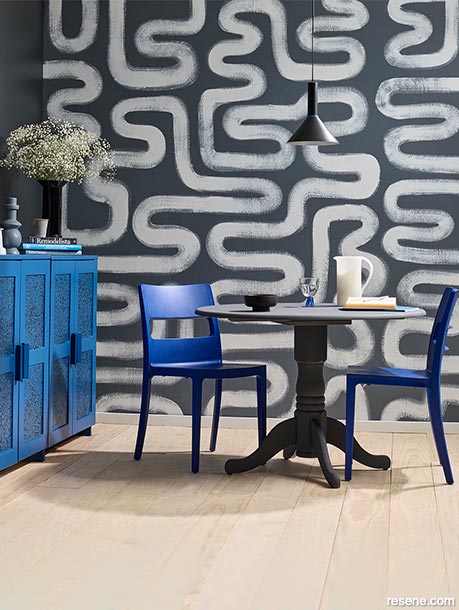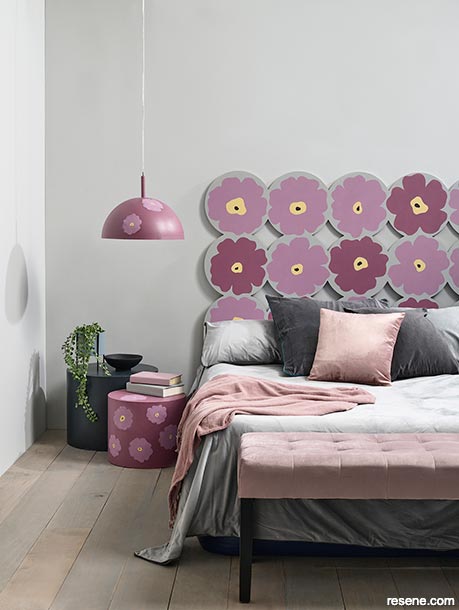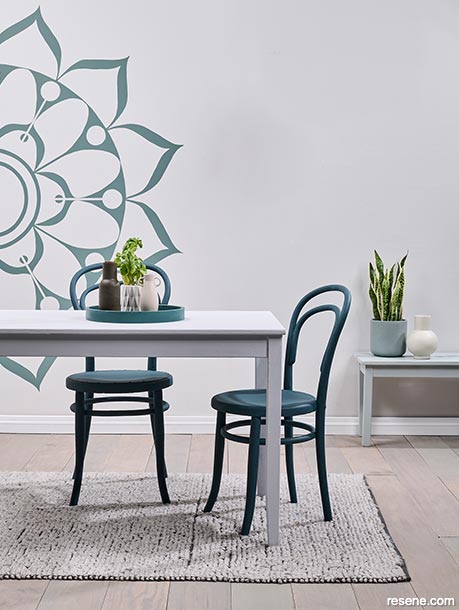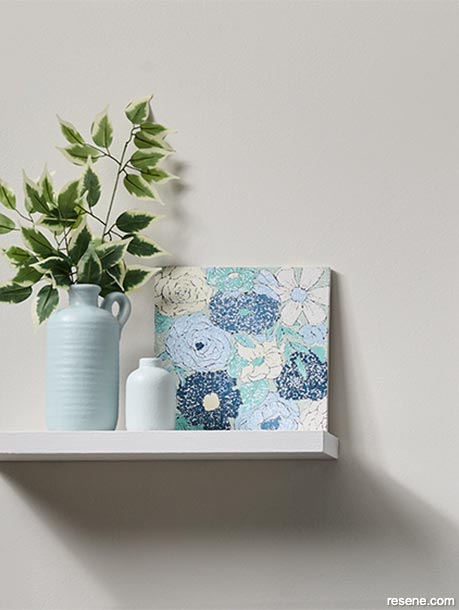From habitat magazine - issue 36, painting for mental health
Ease your stress and boost your relaxation by combining a makeover with mindful design.
In the same way that paint and colour can uplift a room, studies show that painting can positively affect the mind. So why not create spaces you love living in while reaping the health benefits of painting them?


Top tip Allow yourself plenty of time to prep and paint. Painting can be a very satisfying and mindful experience, but it’s best to take your time to do it right. Rushing will just cause mistakes and stress.
As children, we’re encouraged to pursue hobbies and arts and crafts, but as adults with responsibilities and deadlines, these activities are harder to prioritise. Dr Fiona Crichton, a health psychology specialist for mental health app Mentemia, says creativity and recreation should be higher up our priority lists.
Research shows that stress relief and better wellbeing are the benefits of painting and other arts and crafts. So take your inner child by the hand, grab those Resene testpots and get creative – you’ll feel better as a result. “Arts and crafts can act as circuit-breakers for stress,” says Fiona.
“When we are under the pump, feeling pressured or stressed, engaging in activities that require a bit of creative focus and energy can provide our overwhelmed minds with a break. In addition, being present in a task such as painting can act as a respite from worrying and overthinking.
“Artistic endeavours often require attention, which means we are no longer caught up in worries about the future or ruminating about the past – we are in the moment.”
The motion of dipping a roller in paint and letting the roller glide across the surface of a wall is a great feeling and it’s very satisfying to see the result. If you want the experience to last longer, Fiona suggests also diving into other painting activities that are creative, challenging and require concentration.
“Tasks that absorb your attention and provide an achievable challenge can lead to what’s been termed a ‘state of flow’,” she says. “When you find your flow, you are completely in the moment, and time disappears. There have been comparisons with meditation.
“Creative activities that are challenging but doable, such as mastering painting techniques like pointillism or repetitive line design, can be beneficial for wellbeing.”


Top tip Break a large project into smaller manageable parts and focus on what you can achieve in a weekend. That way you can focus on one part at a time and enjoy the satisfaction of finishing before moving onto the next part.
Hannah Tapner worked as a set designer in the film industry before retraining as a yoga instructor and massage (holistic) therapist. She puts her artistic talents to good use at wellness workshops and creative retreats, where she teaches art for mental wellbeing. One of the techniques she teaches is pointillism, an artistic style where small dots are applied closely together to create a larger picture. She uses cotton buds dipped into Resene testpots to create her dot designs. “I like using a cotton bud as it makes the markings a consistent shape. It’s a lovely repetitive action, and very calming to the mind.”
You’ve probably heard the adage, ‘Life is a journey, not a destination’ – well, you can apply the same mantra to painting. Hannah says she’ll sometimes spend years creating an artwork, only to paint over it at the end. Why? Because it’s the act of painting itself that makes her feel her best.
“It’s a process and not an outcome. I’m not necessarily aiming to have a pretty picture in the end. That’s the beauty of paint; you can paint over it and start again,” she says.
One of Hannah’s favourite art forms is the mandala. She was first introduced to the circular designs, which are used in Tibetan Buddhism, during her yoga training in India, where they were used as a meditative activity. Some of her mandalas have taken years to create, but Hannah stresses that the focus is not on the result.
“Buddhist monks will sometimes create mandalas in the sand, and the wind will blow them away over time. I try to think of that when I feel I’m becoming too precious with my designs.”
Many people who come to Hannah’s workshops are worried that they lack artistic skills, but Hannah encourages them to think of the process and not the result. “Try to let go of judgement and the idea of the artwork having to look a certain way and just absorb the enjoyment of the process.”
Studies show that when you set yourself goals and notice progress along the way, you deliver a dopamine hit to your brain’s reward system. Dopamine is one of the feel-good brain chemicals associated with motivation, satisfaction, pleasure and reward. Finishing off a section of your mural or painting part of a room will make painting a pleasurable process.
“Overall, studies show a range of benefits associated with painting, art and crafting,” says Fiona. These advantages include a better ability to cope with stress, a sense of accomplishment, increased confidence, enhanced life satisfaction and improved problem solving skills.
“The idea is to do these activities regularly. Spending a little time every day on creative activities, hobbies and skills development is ideal.”
To learn more about the benefits of creativity and other relaxation techniques, check out the Mentemia app.
For more information on Hannah Tapner’s wellness retreats, visit www.hansi.co.nz.
Mandala means circle in Sanskrit, and these circular designs boast organic or geometric shapes and a defined centre. To paint a mandala, start by painting the background of the wall or canvas using Resene SpaceCote Low Sheen in your chosen Resene colour. To help create a symmetrical design, use a compass or a pencil tied to a piece of string to mark a series of concentric circles lightly. For additional guidelines, divide the centre circle into quarters and rule at least four lines from the centre to create a target-like pattern. Start from the centre, creating designs such as arches or droplet shapes in a circular fashion.
With many of us spending more time inside our homes there’s a growing desire for dedicated hobby, wellness or ‘emotional escape rooms’ which are chill-out zones for crafting, music or even tiny libraries for reading. The key to creating an emotional escape room is to keep clutter to a minimum, add texture to create a cocooning feeling and paint the walls in soothing pale shades (try Resene Escape or Resene Matakana).
On the other hand, you might be the sort of person who needs to let off steam or extra energy after a long day. Searches for ‘rage rooms’ on social media platform Pinterest increased by 150% in the past year. Rage rooms are often dedicated to physical, stress-relieving pursuits such as boxing, martial arts, drumming and wood chopping. Garages are ideal for some of these activities – try decorating with high-energy colours such as Resene Resolution Blue, Resene Dynamite or Resene Turbo.
Whether you’re following colour psychology theory or the principles of Feng Shui, blue and green – the colours of nature – are considered some of the most calming colours. In 2017, 26,596 people from more than 100 countries took part in the World’s Favourite Colour project to research colour and emotions. The study, by paper merchant GF Smith and psychologists at the University of Sussex, revealed that the most popular colour was teal (try Resene Surfie Green), a mix of green and blue. But it also showed that navy blue (try Resene Space Cadet), closely followed by teal-like turquoise (try Resene Blue Chill) and soft pastel pink (try Resene Pale Rose) were other colours that made people feel good. The survey participants associated saturated colours with excitement and stimulation and lighter colours with calmness and tranquillity.
Projects: Kate Alexander, Megan Harrison-Turner, Annick Larkin, Hannah Tapner
Words: Emma Rawson
Images: Bryce Carleton
Search habitat magazine stories
Printed copies of habitat highlights are available from late March 2024 at Resene ColorShops and resellers, while stocks last. You can view back issues of habitat magazine online.
Specifiers:
If you have an idea, project or story that you think would suit habitat, we’d love to hear from you. Please drop us an email with your details and include photos if submitting a project.
Sign up for a DIY card and Save! Australia | New Zealand